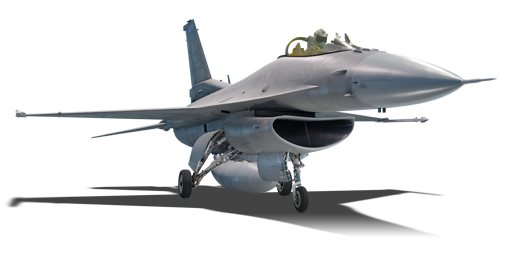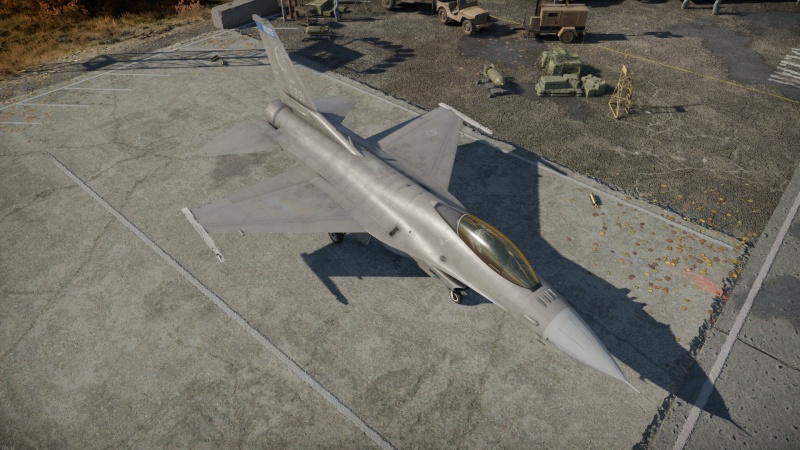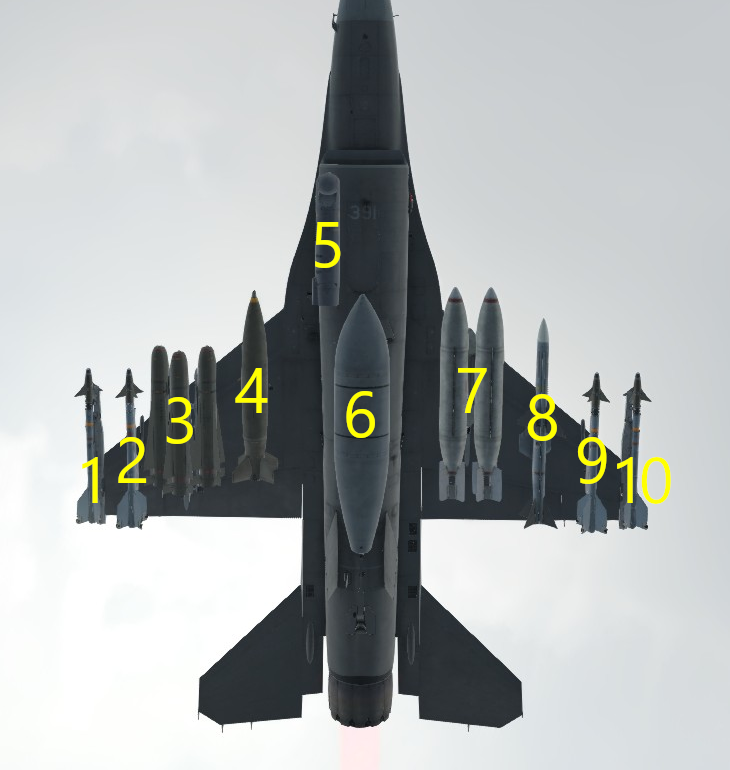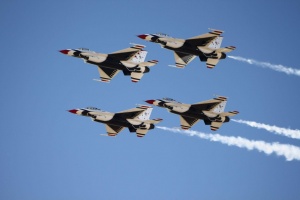Difference between revisions of "F-16C"
(→Pros and cons) (Tag: Visual edit) |
Inceptor57 (talk | contribs) m (→Usage in battles) |
||
| Line 217: | Line 217: | ||
== Usage in battles == | == Usage in battles == | ||
| + | <!-- ''Describe the tactics of playing in the aircraft, the features of using aircraft in a team and advice on tactics. Refrain from creating a "guide" - do not impose a single point of view, but instead, give the reader food for thought. Examine the most dangerous enemies and give recommendations on fighting them. If necessary, note the specifics of the game in different modes (AB, RB, SB).'' --> | ||
| + | |||
'''F-16C Playstyle''' | '''F-16C Playstyle''' | ||
Revision as of 04:51, 6 November 2023
Contents
Description
The F-16C Block 50 Fighting Falcon was a major improvement over the previous variants of the F-16. The previous Block 42 aircraft weighed 3,000+ lbs (1,360 kgs) over the early F-16s. To offset the increased weight, General Electric developed the F110-GE-129 which greatly increased thrust at both low and high altitudes. The Block 50 also received the Westinghouse APG-68 radar which was much faster and generally more reliable. One of the biggest additions to the Block 50 was the ability to fire AIM-120 AMRAAMs and new ground attack munitions. It could also utilize the AGM-88 HARM which was a dedicated SEAD weapon. The USAF received the first F-16 Block 50 in late 1991 and many more were sent to foreign countries as well.
Introduced in Update "Sons of Attila", the F-16C Block 50 Fighting Falcon is an excellent top-tier aircraft. The improved General Electric F110 greatly increases the performance of the Block 50 against enemy aircraft. It excels in dogfighting thanks to its relatively light airframe and better engine. The Fighting Falcon has access to AIM-9M Sidewinders which have a smokeless motor as well as improved IRCCM which makes them an incredibly dangerous missile, especially from rear aspect. Players should be more than satisfied with the F-16C Block 50 against both aircraft and ground targets.
General info
Flight performance
Describe how the aircraft behaves in the air. Speed, manoeuvrability, acceleration and allowable loads - these are the most important characteristics of the vehicle.
| Characteristics | Max speed (km/h at 10,973 m) |
Max altitude (metres) |
Turn time (seconds) |
Rate of climb (metres/second) |
Take-off run (metres) | |||
|---|---|---|---|---|---|---|---|---|
| AB | RB | AB | RB | AB | RB | |||
| Stock | 2,108 | 2,073 | 15240 | 20.1 | 20.5 | 259.5 | 248.3 | 850 |
| Upgraded | 2,235 | 2,170 | 18.9 | 19.5 | 344.1 | 300 | ||
Details
| Features | |||||
|---|---|---|---|---|---|
| Combat flaps | Take-off flaps | Landing flaps | Air brakes | Arrestor gear | Drogue chute |
| X | ✓ | ✓ | ✓ | ✓ | X |
| Limits | ||||||
|---|---|---|---|---|---|---|
| Wings (km/h) | Gear (km/h) | Flaps (km/h) | Max Static G | |||
| Combat | Take-off | Landing | + | - | ||
| 1,555 | 482 | - | 470 | 463 | ~12 | ~4 |
| Optimal velocities (km/h) | |||
|---|---|---|---|
| Ailerons | Rudder | Elevators | Radiator |
| < 680 | < 750 | < 700 | - |
Engine performance
| Engine | Aircraft mass | ||||||
|---|---|---|---|---|---|---|---|
| Engine name | Number | Basic mass | Wing loading (full fuel) | ||||
| General Electric F110-GE-129 | 1 | 9,070 kg | 441 kg/m2 | ||||
| Engine characteristics | Mass with fuel (no weapons load) | Max Gross Weight | |||||
| Weight (each) | Type | 12m fuel | 20m fuel | 30m fuel | 42m fuel | ||
| 1,805 kg | Afterburning low-bypass turbofan | 10,044 kg | 10,606 kg | 11,374 kg | 12,317 kg | 17,874 kg | |
| Maximum engine thrust @ 0 m (RB/SB) | Thrust to weight ratio @ 0 m (WEP) | ||||||
| Condition | 100% | WEP | 12m fuel | 20m fuel | 30m fuel | 42m fuel | MGW |
| Stationary | 6,960 kgf | 11,484 kgf | 1.14 | 1.08 | 1.01 | 0.93 | 0.64 |
| Optimal | 7,241 kgf (1,200 - 1,400 km/h) |
16,488 kgf (1,200 km/h) |
1.64 | 1.55 | 1.45 | 1.34 | 0.92 |
Survivability and armour
Examine the survivability of the aircraft. Note how vulnerable the structure is and how secure the pilot is, whether the fuel tanks are armoured, etc. Describe the armour, if there is any, and also mention the vulnerability of other critical aircraft systems.
Modifications and economy
Armaments
| Ballistic Computer | ||||
|---|---|---|---|---|
| CCIP (Guns) | CCIP (Rockets) | CCIP (Bombs) | CCRP (Bombs) | Lead indicator |
| |
|
|
|
|
Offensive armament
The F-16C is armed with:
- 1 x 20 mm M61A1 cannon, wing root-mounted (512 rpg)
- 120 x countermeasures
Suspended armament
The F-16C can be outfitted with the following ordnance:
| 1 | 2 | 3 | 4 | 5 | 6 | 7 | 8 | 9 | 10 | ||
|---|---|---|---|---|---|---|---|---|---|---|---|
| 500 lb LDGP Mk 82 bombs | 3 | 3 | 3 | 3 | |||||||
| 500 lb Mk 82 Snakeye bombs | 3 | 3, 6 | 3, 6 | 3 | |||||||
| 2,000 lb LDGP Mk 84 bombs | 1 | 1 | 1 | 1 | |||||||
| 2,000 lb LDGP Mk 84 Air bombs | 1 | 1 | 1 | 1 | |||||||
| 277 kg GBU-12 Paveway II bombs | 2* | 2* | |||||||||
| 2,000 lb GBU-24 Paveway III bombs | 1* | 1* | 1* | 1* | |||||||
| BLU-27/B incendiary bombs | 2 | 2 | 2 | 2 | |||||||
| FFAR Mighty Mouse rockets | 57 | 57 | |||||||||
| Hydra-70 M247 rockets | 19 | 19 | |||||||||
| AGM-65D missiles | 1, 3 | 1, 3 | |||||||||
| AIM-7M Sparrow missiles | 1 | 1 | |||||||||
| AIM-9L Sidewinder missiles | 1 | 1 | 1 | 1 | 1 | 1 | |||||
| AIM-9M Sidewinder missiles | 1 | 1 | 1 | 1 | 1 | 1 | |||||
| LITENING II targeting pod | 1* | ||||||||||
| 300 gal drop tanks | 1 | ||||||||||
| Maximum permissible weight imbalance: 2,000 kg | |||||||||||
| * The LITENING II pod must be equipped when carrying guided bombs | |||||||||||
| Default weapon presets | |
|---|---|
| |
Usage in battles
F-16C Playstyle
The F-16C is a purebred squad fighter, performing most efficiently with allied help. A group of 3-4 F-16s is a deadly force to be reckoned with, no matter the enemy. To get the most out of the Block-50, focus on assisting allies and cleaning up baited targets. The F-16 can be a menace by dipping in and out of fights, utilizing its effective HMD to sling AIM-9Ms at slow and distracted opponents. However, due to poor high speed maneuverability, the F-16 should never be found alone, by multiple enemies, especially. Poor high-speed agility can reduce responsiveness times for pilots, giving pursuing enemies crucial space for positioning. The F-16 can be easily overwhelmed when outnumbered, so the best way to combat the weakness is to avoid it altogether. By using careful target prioritization, a Block-50 can kill enemies and free up allies for assistance at the same time. Through practice, you will learn your plane by heart, finally unleashing the full potential of this vicious aircraft.
Pros and cons
Pros:
- Access to potent AIM-9M missiles with the option of a smokeless motor
- Access to a LITENING II TGP in contrast to other F-16 variants
- Large variety of guided ground ordnance
- Better radar than previous F-16s
- Has TWS (Track While Scan)
- Upgraded F110-GE-129 engine with significantly more thrust
- Advanced AN/ALR-56M RWR that can detect a variety of threats
- Access to a voice warning system (Betty)
- Access to a helmet-mounted display (JHMCS)
Cons:
- Bad top speed manoeuvrability
- High fuel consumption
- Internal M61 cannon still has a limited ammo supply
- Worse flight performance than previous F-16s
History
The Block 42 F-16 was very overweight at an astounding 3,000 lb increase over the F-16A/Bs. This was also compounded by the fact that the Block 42 was intended to carry more ordnance and didn't have any significant thrust increase. As a result, the USAF launched the Increased Performance Engine (IPE) program to increase the thrust of the F-16. The Pratt & Whitney F100 and General Electric F110 engines were both redesigned and were much more powerful compared to their predecessors. The F110, found in the Block 50, featured a thirty-percent increase in thrust at low altitudes and a ten-percent increase at higher altitudes. The Block 50 also received the Westinghouse APG-68 radar which had increased reliability and was much faster. The displays in the cockpit were also replaced and an FOV HUD was added. The Block 50 also has access to a multitude of ordnance, and thanks to the improved engine, it can also carry much more. The Block 50 can use the AGM-88 HARM, AIM-120 AMRAAM, new surface target weaponry, SAPHEI rounds (PGU-28), and bombs.
The USAF began receiving the Block 50s in the early 90s and continued receiving them until 2005. After that, F-16 deliveries were exclusively for foreign customers where the F-16 also shined. Further upgrades were done on the Block 50 such as the Block 50 Plus which included more advanced electronics: the radar was improved, a better IFF system was installed, and it could be modified to have conformal fuel tanks (CFT).
In 2001, F-16C and F-16D Block 40/42 and Block 50/52 underwent an upgrade program called CCIP or Common Configuration Implementation Program. Block 50 F-16Cs modernized under this program were identified by the "bird slicer" antennas on the AN/APX-113 IFF interrogators. The CCIP program integrated newer targeting pods such as the Lockheed Martin Sniper XR targeting pod (Phase IB) and the Joint Helmet Mounted Cueing System (Phase II).
Media
- Images
See also
- Related development
External links
Paste links to sources and external resources, such as:
- topic on the official game forum;
- other literature.
| General Dynamics Corporation | |
|---|---|
| Jet Fighters | F-16A · F-16A ADF · F-16C |
| Strike Aircraft | F-111A · F-111F |
| Export | ▄F-16A ADF · ▄F-16A · ▄F-16AM · ␗F-16A MLU · F-16AJ · Netz · F-16D Barak II · F-16C Barak II |
| F-111C | |
| See also | SABCA |
| USA jet aircraft | |
|---|---|
| Fighters | |
| F9F | F9F-2 · F9F-5 · F9F-8 |
| F-80 | F-80A-5 · F-80C-10 |
| F-84 | F-84B-26 · F-84F · F-84G-21-RE |
| F-86 | F-86A-5 · F-86F-25 · F-86F-2 · F-86F-35 |
| F-89 | F-89B · F-89D |
| F-100 | F-100D |
| F-104 | F-104A · F-104C |
| F-4 | F-4C Phantom II · F-4E Phantom II · F-4J Phantom II · F-4S Phantom II |
| F-5 | F-5A · F-5C · F-5E · F-20A |
| F-8 | F8U-2 · F-8E |
| F-14 | F-14A Early · ▄F-14A IRIAF · F-14B |
| F-15 | F-15A · F-15C MSIP II · F-15E |
| F-16 | F-16A · F-16A ADF · F-16C |
| Other | P-59A · F2H-2 · F3D-1 · F3H-2 · F4D-1 · F11F-1 |
| Strike Aircraft | |
| FJ-4 | FJ-4B · FJ-4B VMF-232 |
| A-4 | A-4B · A-4E Early |
| A-7 | A-7D · A-7E · A-7K |
| AV-8 | AV-8A · AV-8C · AV-8B Plus · AV-8B (NA) |
| A-10 | A-10A · A-10A Late · A-10C |
| F-111 | F-111A · F-111F |
| Other | A-6E TRAM · F-105D · F-117 |
| Bombers | |
| B-57 | B-57A · B-57B |








